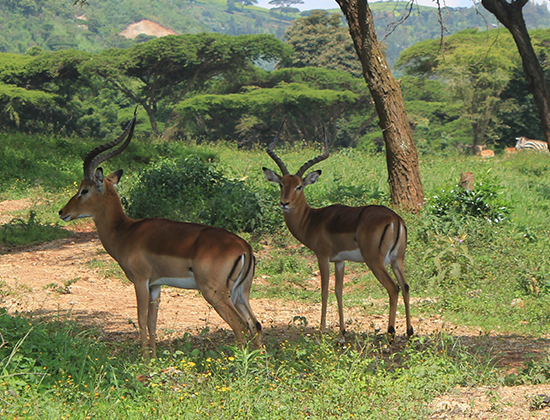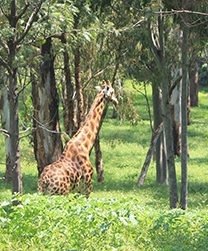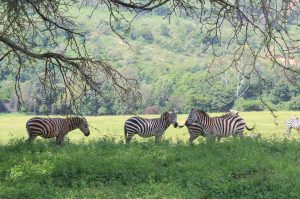

A Tranquil Sojourn in Solai Game Park
As the Amazon rainforest burns without any media interference till Leonardo DiCaprio did, none seemingly cared. Well, no, there are some who do care and do make efforts to conserve the natural habitat. Mansukh Kansagra is one such, whom we met in-person to visit the Park.
Tucked away deep inside the lush, expansive rolling countryside, is the Solai Sanctuary, which is in Tindress Farm, in the Solai area of Nakuru County and lies at the Western escarpment of the Great Rift Valley.
Stretching out as far as the eye can see in every direction, is a veritable Eden: nature at its verdant best in varying shades of green, murmuring whispers of leaves caresses the soul and the sound of running water somewhere in the distance completes the compelling rhapsodic ambience of the sprawling sanctuary. The place is approximately 200 km from Nairobi.
Amid the all-pervading, tranquil stillness giraffes browse among the higher reaches of boughs and branches, with a certain air of curiosity; the zebras prefer to just stand, idling in the warmth of the late afternoon sun. Alongside, a small gathering of deer cast timid glances, cautiously keeping their distance, while the young fawns frisk and gambol without a care. Far away in another corner, a pair of Eland antelopes lazily graze in solitude, because they love to be by themselves.

As we move along, we suddenly come upon the young one of an ostrich, Raju my guide, quickly cuts the engine of his Land Rover, to ensure the poor creature doesn’t run away in fright; it worked. The young ostrich stands its ground giving us a look of casual arrogance.
Several water-bodies, both in the park area and the adjoining picnic spot, fed by the run-off from the Lake Solai, further north, is home to a large variety of water birds.
As the evening shadows grow longer, the litany of water birds fills the air. As twilight descends, the Solai Sanctuary denizens settle down for another night.
The sanctuary is nestled in the eastern arm of the Great Rift Valley with panoramic views of famous geographical features like Lake Baringo, Lake Bogoria, Menengai Crater and Lake Solai close by. There is a viewpoint at the top at an altitude of 7,500 ft above sea level from which visitors savour the rest of the farm and distant features, making the sanctuary a great attraction for education and nature enthusiasts.
Sanctuary owner, Mansukhbhai Kansagra says they have been organising free educational tours to the park for school-children on a regular basis. “Every year we host around 500 primary and secondary school students and about 100 university students from Kenya and abroad. Visitors come from places abroad including USA, Australia, England, the Netherlands and Germany.
“We want to foster in young people the love and awareness about animals in their natural habitat. It is important that children learn from an early age the crucial role plants and animals in the wild play in maintaining the delicate balance and harmony of nature. All the children are also given free lunch snacks”.
He also spoke of an upcoming partnership being worked out between the Solai Sanctuary and the World Wildlife Fund (WWF) to introduce a new kind of educational model for enhanced awareness about conservation of flora and fauna, to inculcate in children a greater love and respect for animals in their natural habitat. This project will be the first of its kind in Kenya.
The farm, which was acquired by the current proprietors in 1966, is located approximately 35 km from Nakuru Town along the Nakuru-Solai road. It is a private, large-scale enterprise engaged in the production of coffee, tea, macadamia, flowers, dairy and allied products and has set aside more than 1000 ha for the conservation of indigenous wildlife and conservation education.
As a part of its social obligation and conservation interests, Tindress Farm offered to set aside a part of the farm to conserve indigenous wildlife that existed in the Solai area outside formal protection and which was posing a serious menace to the local communities through human-wildlife conflict.
The farm then embarked on an afforestation programme which has resulted in the planting of about a million trees in Tindress and its contiguous sister farm, Milmet, putting together more than 1000 acres under water catchment and wildlife conservation which now constitute the Solai Sanctuary.
There is also a pristine and intact riverine forest with visually attractive tree species like the Acacia and which is inhabited by a group of Sykes monkey and diverse bird species.
The sanctuary is home to as many as 324 animals comprising 14 species: Zebras, Impalas, Waterbucks, Thomson’s Gazelle, Coke’s Hartebeest, Grant’s Gazelle, Oryx, Ostrich, Reedbuck, Bushbuck, Duiker, Suni, Eland, among others. Birds living here are Egyptian goose, Paradise flycatcher, White-fronted bee-eater and Black-headed Heron. Other species like the Oryx, Defassa Waterbuck and Rothschild Giraffe have also been translocated here and the sanctuary today boasts of a good diversity of wildlife species, including primates, birds and reptiles.
There is no similar sanctuary in close vicinity with such an assemblage of indigenous wildlife and this makes the wildlife community an exceptional resource value of the sanctuary.
Though there cannot be replacement of Amazon rainforest, let’s come to imagine of a world where people like Mansukh initiate such parks. Not only does this one conserve some species of flora and fauna, but is also imparting education to today’s children who need to understand the value of nature the most. No fundraising, no seminars, no symposiums, but an actual effort towards saving where we live!
Did the Amazon rainforest fire bother you? How do you think you contribute to save mother Earth? Let us know… info@maneeshmedia.com
